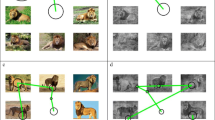Summary
The catching behaviour of the praying mantis Sphodromantis viridis is investigated in order to see whether or not the detection of prey size depends on the detection of prey distance. A first experiment demonstrates the mantid's ability to discriminate small differences in prey distance. Next, the preferred prey size is determined for a number of distances with the preference being indicated by the strike rates. The results demonstrate that the mantid's judgements of size are based on a relative (angular) scale rather than on an absolute (millimetre) scale. This is a strong piece of evidence that a relation between size and distance does not exist. Finally, the attack behaviour is analysed in detail, but it turns out that prey size has no effect on the organization of both the lunge of the body and the strike of the raptorial forelegs. Taken together, the findings of this study suggest that mantids localize prey with precision, but they do so without any knowledge of the absolute size of prey.
Similar content being viewed by others
References
Corrette BJ (1989) Prey capture in the praying mantis Tenodera aridifolia sinensis: coordination of the capture sequence and strike movements. J Exp Biol 148:147–180
Maldonado H, Barrós-Pita JC (1970) A fovea in the praying mantis. I. Estimation of the catching distance. Z Vergl Physio 148:58–78
Maldonado H, Rodriguez E (1972) Depth perception in the praying mantis. Physiol Behav 8:751–759
Maldonado H, Benko M, Isern M (1970) Study of the role of the binocular vision in mantids to estimate long distances using the deimatic reaction as experimental situation. Z Vergl Physiol 68:72–83
Rilling S, Mittelstaedt H, Roeder KD (1959) Prey recognition in the praying mantis. Behaviour 14:164–184
Rossel S (1979) Regional differences in photoreceptor performance in the eye of the praying mantis. J Comp Physiol 131:95–112
Rossel S (1980) Foveal fixation and tracking in the praying mantis. J Comp Physiol 139:307–331
Rossel S (1983) Binocular stereopsis in an insect. Nature 302:821–822
Rossel S (1986) Binocular spatial localization in the praying mantis. J Exp Biol 120:265–281
Schwind R (1978) Visual system of Notonecta glauca: A neuron sensitive to movement in the binocular visual field. J Comp Physiol 123:315–328
Schwind R (1980) Geometrical optics of the Notonecta eye: Adaptations to optical environment and way of life. J Comp Physiol 140:59–68
Schwind R (1989) Size and distance perception in compound eyes. In: Stavenga DG, Hardie RC (eds) Facets of vision. Springer, Berlin Heidelberg New York, pp 425–444
Zeil J, Nalbach G, Nalbach HO (1986) Eyes, eye stalks and the visual world of semi-terrestrial crabs. J Comp Physiol A 159:801–811
Author information
Authors and Affiliations
Rights and permissions
About this article
Cite this article
Rossel, S. Spatial vision in the praying mantis: is distance implicated in size detection?. J Comp Physiol A 169, 101–108 (1991). https://doi.org/10.1007/BF00198176
Accepted:
Issue Date:
DOI: https://doi.org/10.1007/BF00198176




